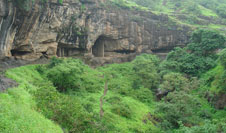 |
|
 |
| Pitalkhora |
|
Cave 4 has a number of carvings of elephants and
horses as well as inscriptions about donors. Among the detached rock is a
carved panel depicting Buddha as a prince, leaving his palace. This is the only
scene from the life of Buddha that has been found at Pitalkhora. |
|
| The damage Cave 5 was a Vihara and contains an
interesting inscription on a loose boulder which mentions a gift by a guild of
bankers. Caves 6, 7 and 8 were all Viharas. 6 has some traces of painting on
the walls. Between 7 & 8 there is an unfinished rock-cut cistern. Cave 9
was an extensive Vihara and still has remnants of plastering and painting. |
| On the other side of the hill is Group II. The caves
here are Chaityas or chapels for prayer and contain stupas. Cave 11 has several
stupas possibly excavated at different times. Cave 13 and 14 share the same
forecourt and contain some very unique sculptures but are both in a crumbled
and damaged condition. |
| Because of its remoteness Pitalkhora has few visitors
and having reached the caves one can almost imagine that one has in fact
discovered them. And there may in fact be more to discover. |
|
| Pitalkhora is 78 kms from Ajanta and can be visited by car, but the climb up
the hill has to be done on foot. Another way of getting there is by taking the
night train from Bombay – Chalisgaon and then a bus to the ancient shrine
of Patna Devi. A short trek and then the climb up the hill. One can also take a
bus from Chalisgaon to Bhamarwadi and from there the caves are about 9 kms. |
|
| Gazetteer of India, Dist. Jalgaon. |
| Ancient India No. 15 “The Rock cut
caves of Pitalkhora in the Deccan”, M. N. Deshpande, Ex. Director General
of Archaeology. |
| Pages --> 1 , 2 |